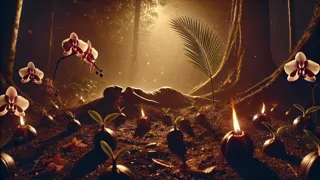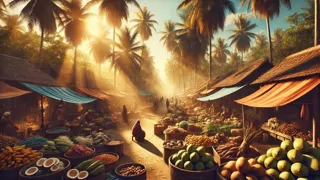Introduction
Beneath the emerald canopy of Sulawesi’s primordial forest, a single orchid bloomed brighter than any other. Among its velvet petals emerged a child the villagers would call Hainuwele—the Coconut Girl. From her coconut-shell cradle, she laughed as birds traced golden arcs overhead, and small animals gathered at her feet. Every day, she leapt and danced across roots and ferns, scattering tiny seeds wherever she went. Those seeds sprouted into yams and taro, bananas and sweet potatoes, weaving bountiful gardens throughout the timbered realm. The people, astonished by this divine bounty, welcomed Hainuwele as a gift from the gods. Yet whispers of envy drifted on the wind as neighboring tribes, envious of Sulawesi’s harvest, plotted to claim her magic. In the hush of night, while moonlight filtered through branches like scattered pearls, they crept upon Hainuwele. In an act born of fear and desire, they ended her bright life and buried her body in the forest’s loam. Dawn found the villagers weeping as petals fell over her grave. But as those petals touched the earth, each transformed into a perfect coconut seed. From that moment, the world awakened to countless crops—the staple sustenance of every people. Hainuwele’s sacrifice had bound life and death in a single gift: the farms and fields upon which all would survive. This is the origin myth of sustenance itself, a tale of divine generosity, human frailty, and the endless cycle of renewal that springs from even the darkest loss.
The Miracle of the Orchid Child
Every dawn for a hundred days, the villagers awoke to tiny sprouts pushing through the moist earth. Hainuwele danced barefoot over mossy logs and tangled vines, her laughter rippling like sunlit water. She gathered wild orchids to fashion into crowns, then tossed their petals into the soil. Wherever they fell, new yams curled beneath the dirt, and young palms unfurled bright-green fronds. The villagers built her a throne of woven vines and offered her gifts of aromatic resins and sweet palm wine. Yet envy found its way even into their hearts. At night, drums sounded in distant hills as envoys from a rival tribe sent word: “We too deserve your miracle. Share the child’s power, or we will take it by force.” For a moment, hope blossomed that Hainuwele might grant her gift to all. But the child knew that divine magic born of life could not share evenly without dreadful cost. In the hush of the forest, she whispered a prayer to her mother, the Orchid Spirit, who answered only in drifting petals. Despite warnings, the envoys crept into the grove on the seventh moon, torches in hand, to steal the child’s magic. In the flickering light, they met Hainuwele’s gentle gaze—and in that moment, the world balanced on the edge between mercy and despair.

[Image here]
When the torches flared orange against the ferns, something in the invaders’ hearts cracked like dry wood. They hesitated, swords raised. The girl stepped closer, palms open, and sang in a voice like rippling water: a hymn for growth and decline, for birth and death. The forest trembled as roots in the earth tightened and the drums in their hands stilled. The intruders, paralyzed between fear and wonder, struck in a single violent burst. Hainuwele fell into the damp grass, her crown of orchids scattering across the forest floor. The killers fled as her song echoed through the trees.
From each petal upon her still chest, a seed emerged—dark, gleaming, and pulsing with life. Each thief—now aghast—watched as the seeds sprouted instantly, sending up shoots and tendrils that laced around ruined torches and discarded blades. Those vines and tubers would feed both tribes for generations. But the cost was written in the silence: Hainuwele’s bright life given so that others might live on anew.
Her body lay beneath orchids and palms until dawn suffused the treetops with gold. Then, as if guided by unseen hands, villagers came to gather the scattered seeds. They pressed them into the fertile soil in neat rows along riverbanks. In time, the unique coconut palms sheathed themselves in husk and hushed sighs of wind. The world would never again be as it was before the Coconut Girl’s gift.
Seeds of Sustenance Spread Across the Lands
Word of the Coconut Girl’s final gift traveled on trade winds and migrating birds, carried by merchants and pilgrims alike. Every market pounded with new fruits: coconuts, bananas, yams—each one tracing ancestry back to Hainuwele’s sacrifice. The Sulawesi people built stone altars around her grave: carved with the shape of an orchid and ringed by young coconut palms that whispered prayers in the breeze. Farther north in the Maluku islands, fishermen wove fragrant baskets of palm fronds to honor her memory before each voyage.

Farmers in distant isles discovered that each coconut from the sacred groves contained an entire orchard of future palms. They pressed their husks into fertilizer, coaxing legumes and vegetables from the soil. Everywhere the seeds spread, civilizations rose—village by village, kingdom by kingdom—rooted in Hainuwele’s final breath.
Yet the goddess’s spirit did not rest. In rainstorms, elders heard her voice in thunder; in gentle mists, they felt her laughter amid dew. Children who knelt among coconut palms spoke to her in secret tongue, asking for guidance before each harvest. And deep within the earth, her orchid mother coaxed new blossoms from the clay, ensuring that life and death remained entwined forever.
Throughout Southeast Asia and beyond, shrines to Hainuwele took myriad forms—tiny shells hung on doorways, carvings on temple pillars, tattoos on forearms. Each tribute was a reminder: from death springs life, and from loss grows the food that sustains all. Her story became a cornerstone of culture, passed from bards to scribes, from shamans to schoolchildren. And though centuries passed, no seed ever failed to take root where her petals had lain.
The goddess’s sacrifice had yielded more than crops. It had rooted a principle into the hearts of humankind: that the greatest gift often springs from the deepest sorrow.
Everlasting Cycle of Growth and Remembrance
Even now, each time a farmer cracks open a coconut or presses its milk into sweet cakes, Hainuwele’s spirit stirs in the breeze. In classrooms, her tale teaches children to respect the cycle of giving: that one life’s end can fuel many to come. Botanists study ancient strains of coconut palms, tracing their genetic lineage back to Sulawesi’s verdant groves. Poets weave her name into laments and odes, celebrating the sacrifice that made fields flourish.

On festivals at harvest’s height, dancers don orchid-shaped headdresses and rhythmically sway among woven palm arches. They tell her story in silent steps—of innocence born, of jealousy awakened, of life blossoming from the loam where she fell. Each dancer becomes both mourner and midwife, ensuring that Hainuwele’s dual roles—bringer of life and harbinger of loss—remain vibrant in living memory.
In laboratories bathed in antiseptic light, scientists extract flavonoids from orchid petals and coconut husks, seeking cures for modern ailments. They marvel at the synergy of two plants intertwined by myth. Fundamental research into seed dormancy and germination repeatedly circles back to the coconut’s uncanny viability—a testament to ancient lore.
For travelers who venture into Sulawesi’s interior, the forest still seems charged. Pathways winding through towering palms lead to hidden glades where orchids bloom in impossible colors. At dusk, fireflies swirl like tiny lanterns, and the hush between cricket clicks carries a sense of reverence. Those who pause in that sacred space often swear they hear a child’s laughter or feel the faint press of a tiny hand against their heart, reminding them that generosity and sacrifice are forever entwined.
From household kitchens to scientific journals, from tribal dances to temple murals, Hainuwele’s legacy endures. It is a reminder that our nourishment often stems from gifts we scarcely understand—and that every harvest carries within it the echo of a lost child’s final song.
Conclusion
Long after Hainuwele became legend, her sacrifice remains the wellspring of sustenance. In every cracked coconut and sprouting yam, the memory of the Coconut Girl lives on. Her final act—offered in sacrifice—taught the world that even the greatest loss can bloom into unimagined abundance. Today, whether farmers murmur thanks at planting, children learn her story in school, or chefs press the milk from a creamy coconut into delicate pastries, they participate in an unbroken cycle begun by a divine child born of an orchid. Each harvest is a tribute to her boundless generosity, each seed a promise that life persists. From the primeval forest of Sulawesi to kitchens across the globe, Hainuwele’s gift endures in every field, every table, every heart that understands how death can sow hope.



















